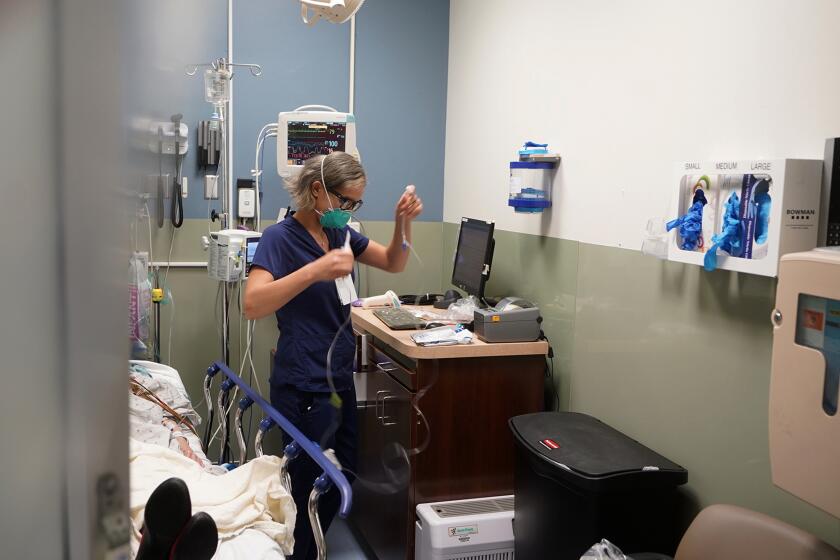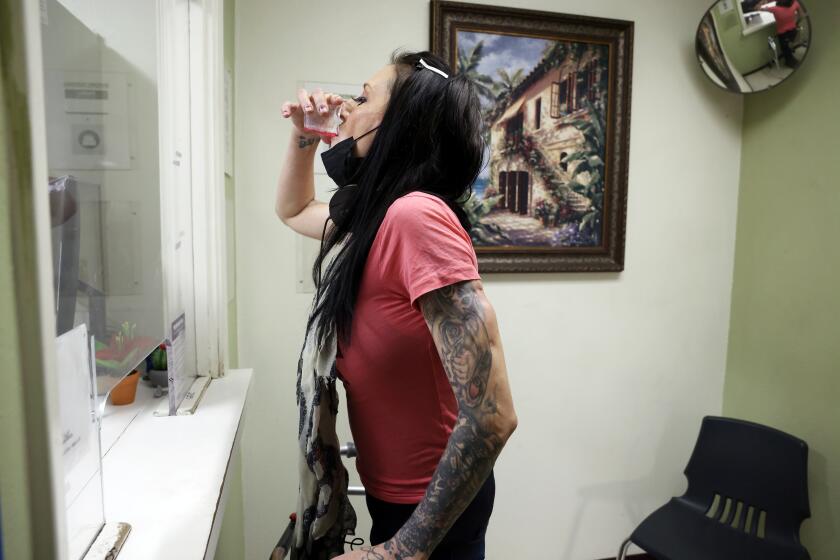Hepatitis C is a slow-moving killer that can be stopped. What’s getting in the way?
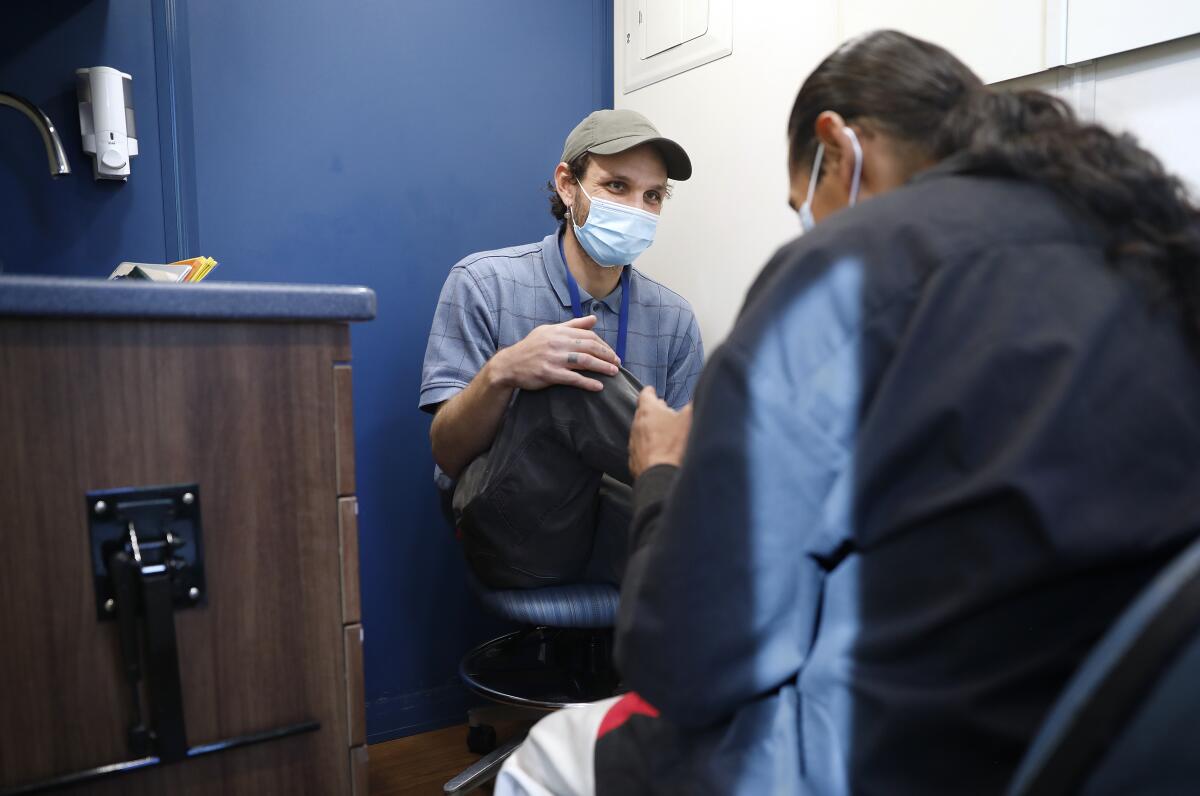
Michael Mendez said that when learned he had hepatitis C, “I didn’t even know what it was.”
Mendez, 47, had been homeless for years in Los Angeles, and said he hadn’t gone to a doctor the entire time he was living on the streets. When Mendez got a roof over his head, at the Arroyo Seco Tiny Home Village, he decided to stop at the UCLA Health mobile clinic that rolled weekly to the Highland Park site — and soon learned about the infection that could jeopardize his life.
Hepatitis C, which spreads through infected blood, causes roughly 14,000 deaths annually across the country, according to federal figures. Doctors describe it as slow and stealthy killer that can take years to show any symptoms. In some cases, the virus may clear on its own, but if left untreated, an infection can also lead to liver disease and cancer.
“If it wasn’t for them, I would still have it,” said Mendez, who was able to get treatment through the mobile program. “And I wouldn’t know what was wrong with me.”
Hepatitis C can now be cured in the vast majority of cases by taking direct-acting antiviral medication for two to three months. Yet only a fraction of people in the United States who are found to be infected promptly start taking the tablets. Researchers from the U.S. Centers for Disease Control and Prevention found that only about a third of patients with private insurance and a quarter of those covered by Medicaid started within roughly a year of getting diagnosed.
Zynteglo is remarkable as a scientific achievement in treating beta thalassemia, a blood disorder. It’s also remarkable for its staggering price.
Being able to cure hepatitis C “is one of the biggest, most exciting developments in medical research in the last 15 years — and most people haven’t heard about it,” Dr. Francis Collins, former director of the National Institutes of Health, told journalists this fall. The newer medications cure most patients, “and the side effects are essentially negligible.”
“So what the heck?” Collins said. “Why do we still have 2½ million people who haven’t had the chance to get tested and treated? Well, it’s because of our healthcare system.”
In a later interview, Collins faulted a “complicated combination” of factors. Costs that led insurance programs to put up barriers. A string of steps to get treated that can become stumbling blocks, especially for people disconnected from medical care. Other experts faulted a lack of public investment and lingering misconceptions among physicians about the treatment.
The virus has disproportionately hit marginalized groups, including people who inject drugs, have been incarcerated or are homeless. A UCLA study published more than a decade ago found that more than a quarter of unhoused adults on L.A.’s skid row were infected. Nearly half of them had no idea, the study found.
Across the country, millions of people are believed to have hepatitis C, but many do not know it. One national study spanning 2011 to 2016 found that less than half of people infected with the virus were aware.
The virus was not identified until 1989, which meant that some people became infected through blood transfusions or other exposure before the threat was understood. It can spread through shared needles or other equipment for injecting drugs, which the CDC describes as the main cause of new infections; experts have estimated upward of 40% of people who inject drugs have hepatitis C. Babies can also get it at birth from an infected mother, and the virus can also spread through unsanitary tattooing or sharing blood-contaminated items such as razors.
When the new medications emerged, health systems like Kaiser Permanente Southern California and Veterans Affairs could reach out to members who were diagnosed with the condition and offer them the pills, but “there’s just no way to do something like that with the Medicaid population,” said Dr. Prabhu Gounder, medical director of the viral hepatitis and respiratory diseases unit at the Los Angeles County Department of Public Health.
“For the past 10 years, the strategy has been, ‘OK, let’s get those people to their doctor,’” said Dr. Jeffrey Klausner, an infectious disease specialist at USC’s Keck School of Medicine. “In reality, we know that many people don’t have a doctor, or it’s too difficult to get access to a doctor. Or then they go to some doctors — and the doctors don’t know how to treat them.”
Experts also said there is scant funding to address the virus compared with other public health threats. At the Los Angeles County Department of Public Health, programs to combat all forms of viral hepatitis get under $1 million in grant funding annually; for HIV, the county department receives nearly $100 million in grants annually, Gounder said.
The California Department of Public Health said it did not know what percentage of Californians with the virus had obtained antiviral treatment. In January 2022, California started requiring clinics and other primary care providers to routinely offer screenings for hepatitis C and follow-up care to those who test positive, but Gounder questioned whether the requirement was being widely followed, since “there’s no enforcement behind it.”
Many primary care doctors still shunt hepatitis patients to specialists unnecessarily, experts said. Sonia Canzater, director of the Hepatitis Policy Project at the O’Neill Institute, said some doctors may have enduring memories of the earlier, much more complicated treatments, which “came with a myriad of side effects.”
Treating hepatitis C is now “simpler than diabetes. It’s simpler than hypertension,” said Dr. Norah Terrault, chief of gastroenterology and liver diseases at Keck, who founded a program to teach primary care physicians about treating the illness. Many mistakenly believe assessing patients for the treatment is complicated, and “it’s so hard to get them in the door. But once they’ve treated their first patient and they get that sense of, ‘Oh, my gosh, I just cured someone and it was so easy,’ then they become advocates.”
Getting through the steps to the cure can nonetheless be an obstacle course for patients, especially if they have no transportation or time off to head to a clinic, or fear leaving belongings behind at a homeless encampment. If a rapid test comes back positive, more blood work is needed to check whether it is a current infection or old antibodies. Some patients may also need an ultrasound.
In Highland Park, Mendez was treated through a study that is assessing the effectiveness of a “one-stop” mobile unit to link people who inject drugs to health services, including treatment for hepatitis C.
For patients in the program, “there’s not a lack of interest” in the cure, said Dr. David Goodman-Meza, a UCLA assistant professor and principal investigator for the Los Angeles sites in the study. “It’s the difficulty navigating the system.”
Mendez was able to get his blood drawn in the mobile unit. He had a virtual visit with a UCLA hepatologist. The pills were brought to him. Mendez said that if he had to make it to clinic appointments farther away, he probably wouldn’t have gotten through the process.
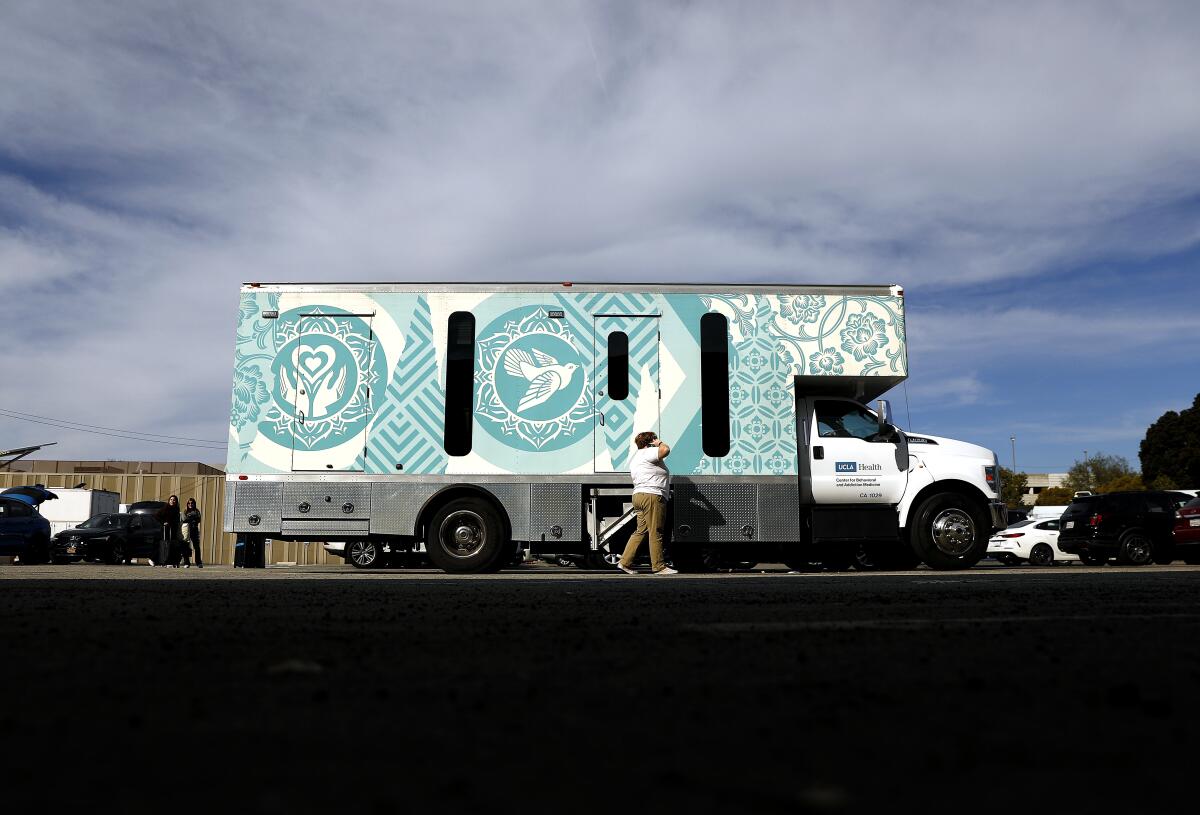
“It’s too much,” said Mendez, who gets around on foot. “Just trying to get there. Being on time.”
When the pills first came on the market, they were extremely expensive — sometimes upward of $80,000 to treat each patient. Insurers limited who could obtain them. In many states, Medicaid programs would not let patients begin treatment until there was a minimum level of liver scarring, a rule Canzater likened to “waiting until you’re down to one lung to give you chemo.”
Prison systems also restricted access to the curative pills, the medical news outlet STAT reported: More than 1,000 people in state prisons across the country died of complications from the virus in the six years after the medication was available, its investigation found. Some insurance plans also required patients to have stopped using drugs or alcohol or only permitted specialists to prescribe the medication.
In San Diego, Dr. Christian Ramers said he was turned down dozens of times by insurers when he first started trying to prescribe the medication at a community clinic run by Family Health Centers of San Diego in the basement of a homeless shelter.
“I have the ability to treat hepatitis C. They have cirrhosis already, so they’re in bad shape. And I am forced to refer them to a different specialist,” said Ramers, an infectious disease specialist. “It just got comical and ridiculous. ... The whole system was set up to not treat people.”
In California, many of those obstacles were stripped away for Medi-Cal patients after physicians like Ramers testified in Sacramento. Restrictions are still around in Medicaid programs in many states, although they grew less common between 2014 and 2022, researchers from Harvard and the National Viral Hepatitis Roundtable found.
Costs for the medications have also fallen significantly, experts said, with treatment courses now ranging from roughly $20,000 to $30,000, although Collins said that is still steep for many public programs.
When people on L.A.’s skid row want to try to wrench free from opioid addiction, the closest options for getting daily methadone may be miles away.
But Ramers said COVID-19 “came at the worst time for the hepatitis C elimination movement.” Testing and treatment for hepatitis C dropped when the pandemic began, one national study published in the American Journal of Preventive Medicine found.
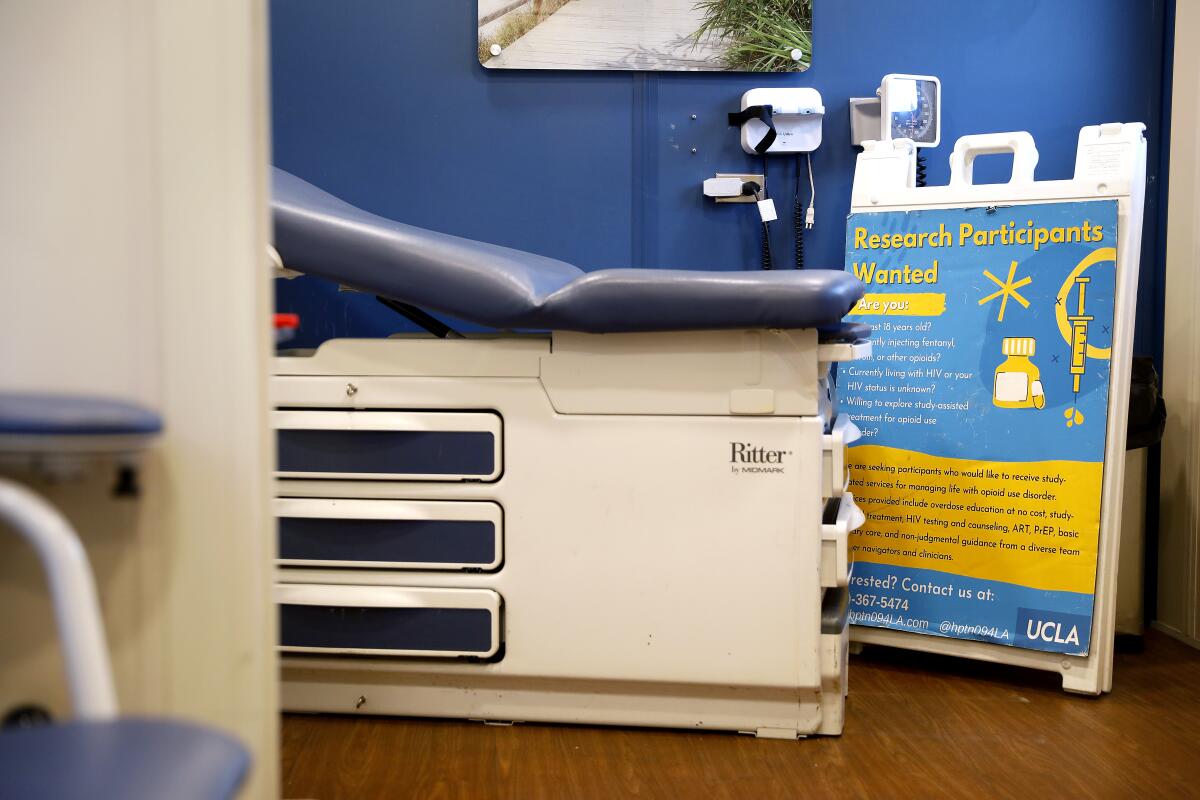
More than a third of California healthcare and social services providers surveyed in spring 2020 by the California HIV/AIDS Policy Research Centers said they had pared back or suspended their hepatitis C testing; by fall 2021, more than a quarter were still reporting they had reduced viral hepatitis testing.
Collins, a special projects advisor to President Biden, has been working on a national initiative to tackle the threat. He wants to ensure “point-of-care testing” to allow people to start treatment the same day, expand training for physicians, and bring down the costs of the medication.
He argued that an upfront investment in curing the virus would save the later costs of cirrhosis and cancer: One recent study analyzing the Veterans Affairs system estimated that treating each hepatitis C patient would save more than $62,000 over time.
In Highland Park, Mendez is waiting on another blood test to confirm he is cured. He has been telling friends about the UCLA mobile program and the pills that can wipe out hepatitis C, urging them to “jump on it as soon as possible.”
“It’s either that,” he said, “or your life.”
More to Read
Sign up for Essential California
The most important California stories and recommendations in your inbox every morning.
You may occasionally receive promotional content from the Los Angeles Times.
